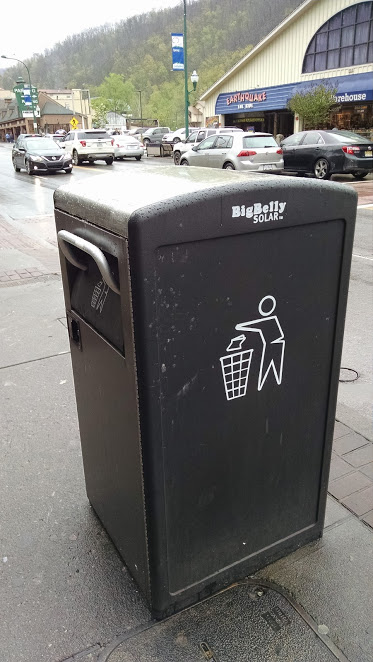BY NAN K. CHASE
News that the city of Asheville failed to meet waste and carbon reduction goals [“City Sustainability Efforts Fall Short of Annual Goal in 2017,” April 18, Xpress] sent me to an unlikely place for solace: Gatlinburg, Tenn.
Gatlinburg, like Asheville, has a thriving hospitality industry going back generations; Gatlinburg also has a beautiful mountain setting, a stock of historic buildings and a legacy of fine handicrafts.
And Gatlinburg, like Asheville, welcomes more than 10 million visitors a year. The difference is that Asheville has a year-round population close to 90,000, while Gatlinburg has just 3,900 residents.
Yet Gatlinburg makes environmental and economic sustainability for its tourism economy the community-wide priority — air and water quality, pedestrian-friendly practices, waste-stream and energy-use reduction, even automation.
One benefit of this constant innovation has been to free up the city’s maintenance staff for other tasks in a tight labor market. Such productivity boosts are helping public and private sectors alike.
Asheville’s city employment rose 6.5 percent over two years, while Gatlinburg’s city staffing remains at least 10 percent below peak pre-recession levels, according to City Manager Cindy Cameron Ogle. “We try to be as lean and mean as we can be,” she says. Total full-time employment is 257; Asheville’s is 1,185.
During late April, officials in Gatlinburg organized half a dozen on-site interviews for me so I could get a close look at sustainability methods.
Most amazing is Gatlinburg’s pioneering waste processing plant, which attracts observers from around the world and turns the idea of recycling on its head. Operating two sets of trucks — garbage and recycling — and collecting two sets of bins is just not energy smart or environmentally friendly because more trucks are costlier and produce more pollution. Even in a progressive city, I learned, as little as 20 percent of the population may actually participate.
In the Gatlinburg area, trash and recyclables are processed together, aerobically “cooked” in gigantic rotating drums for three days, then chopped and sifted and aged a month to become Grade A compost. As unlikely as it sounds, 150 truckloads a day of mostly bagged garbage — with jars, bottles, cans and a lot more included — are fed into the drums, along with some already composted material to act as “starter.” Ridges inside the long drums help break up plastic and other noncompostables, and by the end of the screening and chopping process, nothing larger than a quarter inch remains in the new soil, which is like dirt with a lofty, slightly paper-enhanced feel.
Sixty percent of trash and recyclables become composted soil, which then goes to farmers, landscapers and other bulk users. It’s free to residents. Another 10 percent of the waste stream is brush and limbs, which are also processed on-site and used in part to filter composting odors. (Building waste and major commodities are not included in this waste collection stream.)
Two employees — the workforce numbers 21 — are close to perfecting a new technique for reclaiming aluminum cans from this composting process for resale, and that could produce significant income. Removing aluminum, tin and plastics would get this plant’s “capture rate” to 90 percent, leaving just 10 percent as landfill. Plant managers say that lab analysis shows the composted soil is safe for home and agriculture, despite the occasional can of paint that goes through the system.
Overseen by a multijurisdictional board, Sevier Solid Waste Inc. serves Gatlinburg, Sevierville, Pigeon Forge, plus Sevier County, Dollywood and the Great Smoky Mountains National Park, as well as commercial clients from as far away as Atlanta. The incoming waste stream, excluding wastewater treatment sludge, totals 300 tons a day, according to General Manager Tom Leonard. Gatlinburg’s trash, like Asheville’s, is rich in leftover organic material from restaurants, perfect for the drum system.
The facility cost $25 million to build, the same amount that Buncombe County will spend on repairs and renovations to Asheville High School. By comparison, a $20 million multijurisdictional project, completed in 2014, was Gatlinburg’s recession-busting Rocky Top Sports World public venue, a sports tournament destination with both indoor and outdoor facilities that’s projected to yield $40 million in visitor impact this year.

Both the city of Gatlinburg and at least one top tourist destination, Ripley’s Aquarium of the Smokies, realize big savings in BigBelly trash cans for the busiest public spaces. These $5,000 receptacles feature solar-powered compactors: When trash reaches a certain volume, a GPS sensor signals a trash truck or maintenance employee (earning raves for efficiency). Ripley’s Aquarium invested in eight BigBellies, and the city leases several but put expansion plans on hold after the 2016 wildfires.
At Gatlinburg’s convention center complex, a quarter million square feet cleverly tucked away downtown, Assistant Building Supervisor Scott Murphy showed me how a close look at lighting led to big energy and labor savings. Adjustments in lighting procedures — involving turning lights off in nonpeak hours rather than lowering them for ambiance, and reducing indoor temperatures — saved over 1 million kilowatt-hours of energy a year, while changing fixtures in the main hall from 400-watt halogens to 250-watt induction lighting, with similar step-downs elsewhere, halved energy use in the room. The payback period, using some matching grants, was about four years.
Everywhere I looked, the takeaway was the same: The big changes needed to meet ambitious sustainability goals take big financial investments. Not once, but year after year.
Nan K. Chase is the author of Asheville: A History. She serves on the board of the Friends of the North Carolina Room at Pack Memorial Library.





Gatlinburg also has Dolly Parton’s little Nasheville enclave that makes Branson, Missouri look good
for cheap white trash overproduced ‘country’ culture.
Don’t get me wrong, Dolly. Much like Jimmy Carter, your philanthropic efforts rock but your slicked up music
sucks. Much like Carter the 1 term POTUS with nary a shot fired is considered a weak Prez now for doing so much good for the poors.
Other than that, yeah, Gatlinburg, you rock with that sustainability thaing.